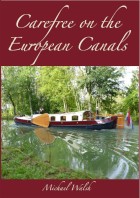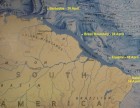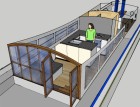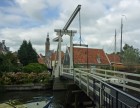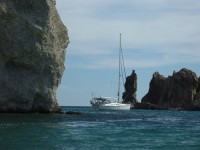Sequitur
Michael & Edi have headed out on a slow, thorough exploration of the globe.
| Vessel Name: | Sequitur and Zonder Zorg |
| Vessel Make/Model: | 2007 Hunter 49 and 1908 Wildschut Skûtsje |
| Hailing Port: | Vancouver, Canada |
| Crew: | Michael Walsh & Edi Gelin |
| About: | For our current location click, on Map & Tracking, then on the Google Earth logo. |
| Extra: | Follow us on Twitter: Follow @YachtSequitur |
| Social: |
13 January 2014
Another New Book Released
I am delighted to announce that my new book: Carefree on the European Canals is now in print and is available on Amazon.com, Amazon.ca [...]
26 April 2013
New Book Released
The proof copy of my new book arrived by courier today. I have approved it and it is now listed on Amazon for pre-order, with a publication date of 30 April. It is a rather large book at 680 pages in an 8.5 by 11 inch format with 315,000 words illustrated by over 2400 colour photos, charts and maps. [...]
24 April 2013
One Year Out of Brazil
One year ago today we sailed Sequitur out of Brazil after enduring more than six weeks in the least-friendly country that we had experienced during our three-year voyage. In the early evening of 24 April 2012 we crossed the line on the chart dividing Brazil from French Guyana and breathed a huge sigh [...]
27 October 2012 | Harlingen, Friesland
Planing a Metamorphosis
We have added a new post to the Zonder Zorg blog at: Planing a Metamorphosis.
29 September 2012 | Sneek, Netherlands
Onward to Friesland
We have arrived in Friesland and have added a new post to the skûtsje's blog at: Onward to Friesland
19 September 2012 | Hoorn, Netherlands
North From Aalsmeer
We have moved northward from Aalsmeer and I have added two new posts: Heading North From Aalsmeer and North From Amsterdam
13 September 2012 | Aalsmeer, Netherlands
Taking Possession
We are back in the Netherlands, and I have added some new posts to the ZonderZorg blog at: Taking Possession and Settling-In and Making Plans
20 August 2012 | Sequitur: St Augustine, USA - Michael & Edi: Vancouver, Canada - Nieuwe Zorg: Aalsmeer, Netherlands
Added a New Website
We have added a new website: Skûtsje ZonderZorg. Zonder zorg in Dutch means without worry. Our intention with the site is to provide a place to share some of the history, geography and culture of the skûtsje as we discover it. We will also use this place to document [...]
11 August 2012 | Sequitur: St Augustine, USA - Michael & Edi: Vancouver, Canada - Nieuwe Zorg: Aalsmeer, Netherlands
Still More Skûtsje History
We continued to attempt to track-down Douwe Albert Visser, who was the owner of Nieuwe Zorg in 1941 when she was re-registered. One of the problems we repeatedly encountered in our online searches was the effect of currently having Albert Visser and two Douwe Vissers as very competitive skûtsje racers, [...]
10 August 2012 | Sequitur: St Augustine, USA - Michael & Edi: Vancouver, Canada - Nieuwe Zorg: Aalsmeer, Netherlands
Some More Skûtsje History
While I was researching the history of Nieuwe Zorg, I finally found her first registration details obscured by an apparent typographical error in a transcribed online spreadsheet. She was listed as having been built in 1901 instead of 1908. I emailed the webmaster of the [...]
Awaiting Haul-Out in Peru

Lima has a population of around nine million and it is linked by a public transit system with over 650 routes served by buses, microbuses, and combis operated by over 450 private companies. The system is very obviously unorganized and it appears to be unregulated by the local government. Miraflores is an upscale suburb, standing on a line of cliffs above the Pacific on the southwest side of metropolitan Lima, some eighteen kilometres along the coast southeast of La Punta.

There was a steady flux of passengers in and out of our very crowded van on the fifty-minute trip to Plaza 2 Mayo in central Lima. As soon as passengers vacated seats, the conductor would chant the destinations and heckle fresh passengers aboard. We were seldom less than full; at times there were passengers standing crouched in the low-roofed van, waiting for a seat. For most of the ride, we were twelve to fifteen in a converted nine-passenger van. Our fare was 1.2 Soles each.

From Palza 2 Mayo, we walked east along Nicolas De Pierola four blocks until we came to Wilson, a major cross street leading off to the south, toward the coast, and we spotted a bus with a Miraflores sign among its half dozen destination placards. This small bus was more roomy and comfortable than was the van, and the fare for the fifteen or so kilometre, forty minute ride was another 1.2 Soles each.
We walked around for a while, getting our bearings and then stopped for a pizza at a very clean and modern Burger King / Pizza Hut on the edge of Parque Kennedy. It was the first time I've been in a Pizza Hut in two decades or more, but it somehow seemed appropriate. I guess it's the old "when in Peru, do as the Peruvians do" type of thing. The place was busy.

We continued sightseeing and exploring on foot and walked along Bolognesi, past the Canadian Embassy on our way to the malecon above the cliffs overlooking the ocean. There was a falcon soaring in the updrafts and we watched it for a while as it interacted with the falconer.

Along the cliff tops is a broad park with paved cycle and walking paths leading past well-manicured lawns and flower gardens. We followed the walkway northward, toward El Faro Miraflores, the lighthouse. Through the haze we could see the peninsula of La Punta forming the northwestern horizon.

We continued on past the lighthouse, passing an unbroken line of luxury high-rise condominiums. Most of these were very modern with wonderfully creative architecture, and by the quality, we could have been in West Vancouver, or along Vancouver's Coal Harbour or False Creek, or in any other world-class waterfront community.
We left the cliff-top park and walked back into the built-up area to find a street with busses heading northward toward Callao and La Punta. We eventually hopped into a crowded van with La Marina and Callao among its displayed destinations. The asked fare was 1 Sole each. After nearly half an hour we unfolded ourselves from the van in front of the Wong supermarket on La Marina in San Miguel, and shortly boarded a small bus tagged La Punta, which for 50 Centimos each took us to the Yacht Club. Our triangular route had taken us over 50 kilometres for a total of 3.9 Soles each, about $1.40.
On Thursday, we went ashore to do a careful measurement of the Yacht Club's travel lift, and determined the actual clearance under the cross-bar is 5.48 metres, not the 5.9 metres that we had been told. My measurements of Sequitur show that she needs a minimum of 5.8 metres under the cross-bar. Jaime suggested that they could hoist Sequitur and do the bottom work while she hangs there in the slings, and that they have staging that easily slides under the boat for the workers. To me this seems an excellent solution, and I asked him to proceed with organizing it as soon as possible.

It turns out to be very good timing for this; the pier is being rebuilt in sections to replace corroded ironwork beneath its concrete roadway. The demolition, the installation of new steel work and the pouring of new concrete makes it very complicated for the travel lift to negotiate temporary steel girders that span the construction site gap. Because of this, tying-up the lift by our hanging in it will be of very little, if any inconvenience.

Friday the 1st of October was the beginning of our second year on this cruise; it is hard to believe it has already been a year since we left Vancouver. We went ashore and talked again with Jaime to reiterate our desire to be hauled-out as soon as he can organize it. We then went wandering, and in the late afternoon we stopped at the Yacht Club restaurant on the pier and sat on the upper deck in the sun enjoying broiled scallops and Peruvian Pilsner.

The scallops whetted our appetites sufficiently that we ordered a couple of plates of lomo saltado. We find it amusing, that here we are in the home of the potato, with over 200 species and 4000 varieties, and we discover variety 4001. The fries that came with our lomo soltado are McCain's frozen. McCain's started in my home province of New Brunswick over half a century ago and they are the world's largest producer of frozen french fries. They processes one million pounds of potato products each hour with 55 factories in 12 countries on six continents, and they sell one-third of the world's frozen potatoes to more than 110 countries. The lomo saltado was delicious.

As we were eating, the travel lift was slowly juggled out of the yard through the clutch of boats tied-up by the construction. As this was going on, workers arranged steel I-beam assemblies to temporarily span the demolished portion of the pier.

Just as we were finished our meal, the travel lift made it over the temporary span, and was left on the pier overnight, to continue the launching process in the morning.
On Saturday we talked with Jaime, and he said they should be able to haul Sequitur on Monday or Tuesday. We had hoped it would be sooner; we'd been back onboard from our Vancouver trip for over two weeks and since we're not making water in the anchorage, our water tanks were getting down to the empty mark. We had been waiting to fill the tanks until we were at the pier.
On Sunday afternoon we took a minibus to Plaza San Miguel to search for water jugs or jerry cans to use to bring water out to Sequitur from the pier. We explored Sodimac, a Canadian Tire-type big-box store, and at one point we had three clerks engaged in trying to determine exactly what we were looking for. Eventually we were sent upstairs to their sister store, Tottus, another big-box, this one a combination of supermarket, clothing and house wares stores. We struck-out on jerry cans, but I did find some deeply discounted polar fleece. I bought a very nice zip-pocketed vest, a similar jacket and a zip neck pullover for the equivalent of $6.25 each.

We walked along La Marina and then across to the Maestro, a Home Depot-type big-box store, where we eventually found 18.9-litre jerry cans, and bought two at 54.90 Soles, just under $20 each. The buses were very crowded, it being the municipal and district election day, and we crammed our way onto a minibus back to La Punta. We were among the few onboard without purple-stained fingers from the polls, but seeing the profusion of candidates on banners, posters and placards, and the apparent dozens of political parties in the race, we were likely no more confused than were the voters.
We filled our new jerry cans on the pier and started the process of refilling our water tanks. If we ferry the pair of jugs each day, we'll stay ahead of our consumption, and gradually top-up the tanks. The jerry cans are very well designed, with a breather built into the spout, and the can's shape is perfectly suited to our filler holes, so that the filling process is hands-free once started.

Early on Monday morning we caught a launch to the pier to go to the Makro with Frano. We had seen him on Sunday afternoon, and he had told us he was taking Jill of Companera and Sandy of Volo shopping, and he invited us along with them. Makro is a members-only store, somewhat like Costco, and Frano offered to use his card for us. We replenished some of our staples, and we bought some things to try to determine whether larger quantities of them were warranted. Among these was a Peruvian coffee, Cafetal Selecto, which from our first cup the next morning, we pronounced to be as good as our current Starbuck's House Blend.
On the way past the Yacht Club office, I stopped in to speak with Jaime about our haul-out, He said it could be Tuesday, but would probably be Wednesday before they would be able to do it.
On Tuesday, while on our jaunt ashore for water, we stopped in to see Jaime, and learned that he was away for the day, so it looked like Wednesday for haul-out, at earliest. We then went to the small market around the corner on Bolognesi and bought some yams and a nice bunch of asparagus, which is now coming into season. We also bought a kilo of eggs, which here, as in Mexico are brown, unless you want to pay a premium for white ones. We find we are using more eggs these days, often as omelette or a frittata in the evening. We seldom have eggs for breakfast; though, preferring instead to have bagels and cream cheese with our coffee.

We have finally run out of bagels, and so far we have not been able to find any in Peru. So taking matters in hand, on Tuesday afternoon Edi made a small batch to see how Sequitur's galley would fare.

It was a bit cool, so the yeast may not have been working to its best advantage; however, the finished product turned-out splendidly. We sampled our first one while it was still piping hot. Even ignoring the Edi factor, both in flavour and in texture, I preferred it to Vancouver's famous favourite, Siegel's.

On Wednesday morning we sat down to a delicious breakfast of toasted home-made bagels, Peruvian queso crema and steaming cups of our newly discovered Starbuck-beater Peruvian coffee.
After breakfast I went ashore to get water and to talk with Jaime about our haul-out. He told me that it now looks like it won't be possible until early next week. I told him that the level of fuel in our tank was below the inlet level for the Espar heater, so we have no heat or hot water onboard, and that we had been waiting until after haul-out to fill-up. Also the fuel level is below the intake for the generator, and without fuel we cannot try it to see if my attempts at repairs have been effective or not. Jaime said he would arrange a yard boat to tow us over to the fuel dock in the next day or so.

The weather here continues to be cool and humid, the temperature ranging from lows of 16 or 17 to highs of 19 or 20, and there is a near constant overcast, which the sun sometimes manages to burn through for a short while in the mid-afternoon. We are only 12 degrees off the equator and the sun is nearly directly overhead at the moment, so even with the overcast, our solar panels put-out 12 to 18 amps mid-day.
The overcast here is generated by the cool moist air over the north-flowing Humboldt Current meeting the hot dry air over the coast. The time of sunrise is currently getting earlier by about half a minute per day in Lima, and the length of day is increasing at the same rate. The time of sunset stays the same from mid-August through mid-October. For those two months, it sets at 1804 every day. Often the sun will break out below the cloud bank a minute or two before it sets, and we enjoy a very brief bit of sunshine.

On Wednesday evening we had chicken breasts sauteed in butter and tarragon, accompanied by basmati rice and steamed asparagus with mayonnaise. With it we enjoyed a bottle of Riccadonna President Brut, which I hadn't had since the early 80s when I used to market it.
On Thursday we went ashore by launch to catch a bus to San Miguel to do some produce and grocery shopping. On the way by the office, we spoke with Jaime about our haul-out, and to try to arrange a workboat to take us in to the pier to take on some diesel. He said the haul-out looks likely for Monday, and he told us he could organize the workboat immediately. We cancelled our plans to go shopping.
Jaime told us that the fuelling process requires us to go to the second floor of the Yacht Club and pay for the quantity we want, and keep the voucher to show at the pump. He would arrange a workboat to meet us at Sequitur. We walked along to the small foreign exchange office on the corner and exchanged some US Dollars for Soles. The margin between the buy and sell rates was one of the tightest I have seen: buy at 2.71 and sell at 2.76, a margin of just over 1.8%.
We went to the Club and paid for 30 US gallons of diesel at 12.5 Soles, which is $4.50 Canadian per US gallon, or slightly less than $1.20 Canadian per litre. The 30 gallons should bring the level of fuel in the main tank above the intake for the Espar furnace and the Fischer-Panda generator. This would mean heat and hot water and electricity, and would be an enormous improvement to our creature comforts. We told Jaime we had the fuel voucher and that we were heading back out to Sequitur to wait for the workboat. He said he would send one out shortly.

About an hour and a half later, a workboat arrived and I passed them a line and then let go from the mooring. The little boat pulled us through the mooring field and over to the end of the pier. There was an offshore breeze of 10 to 12 knots, and I used Sequitur's rudder to track closely behind the workboat. As we approached the pier end, I turned hard to port and tossed a line to the attendant as our stern swept past. The workboat picked-up the strop from the mooring and I went forward to secure to the mooring. It was a simple operation that had us balanced between stern line to the pier and a bow line to a mooring.
I passed another line to the pier to haul across the fuelling nozzle, and we took on 30 US gallons of diesel. While the diesel was slowly pumping, I brought across the water hose and began filling the tanks. We figured we might as well top them right up; with the sliding schedule our haul-out has seen so far, we could only guess how long it might be before we are actually hauled. We will likely have depleted much of the additional 500 kilograms of water before then.
We were securely back on our mooring at 1735, just four and a half hours from speaking with Jaime. I switched on the Espar furnace, and after a failed start, I figured that it needed a longer priming from having run out of fuel. I tried it again, and it flashed-up and ran. We now have heat and hot water. I tried the Fischer-Panda a couple of times without success. At least now it has its fuel intake in the diesel, and with fuel, I should be able sort it out, working from the simple fixes to the more complex. But it was late, and that will need to wait for another day.

